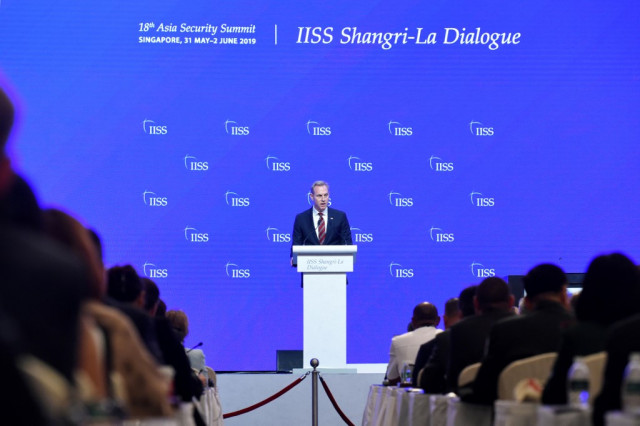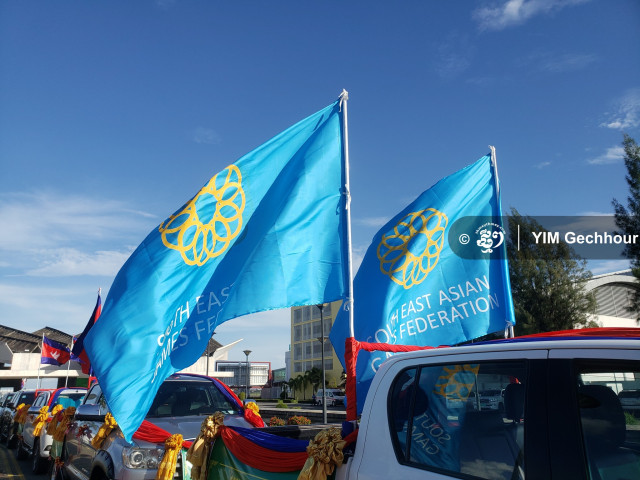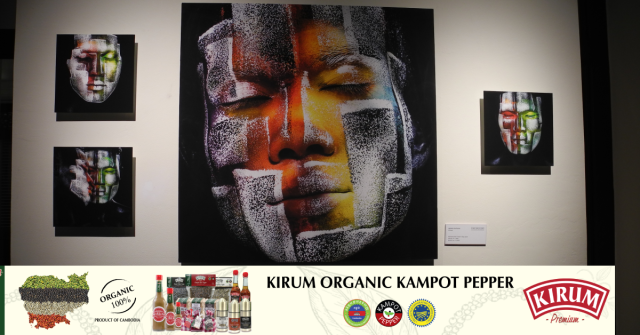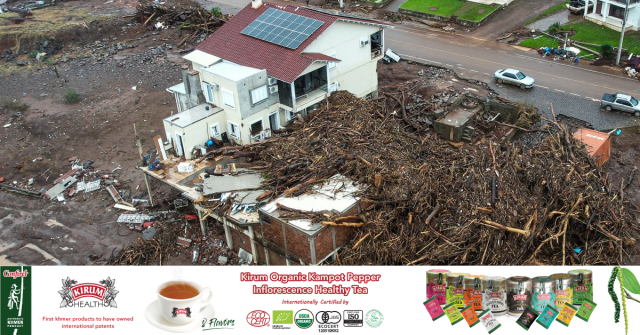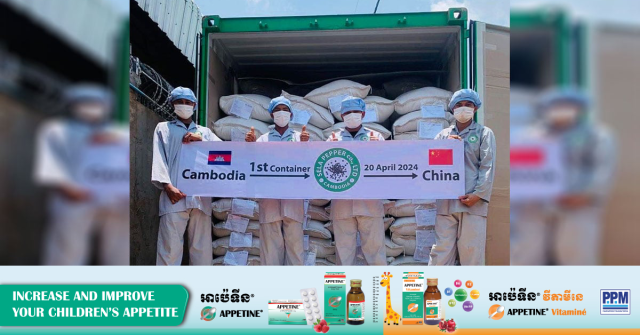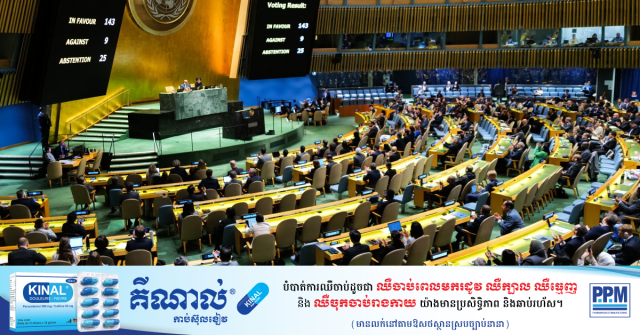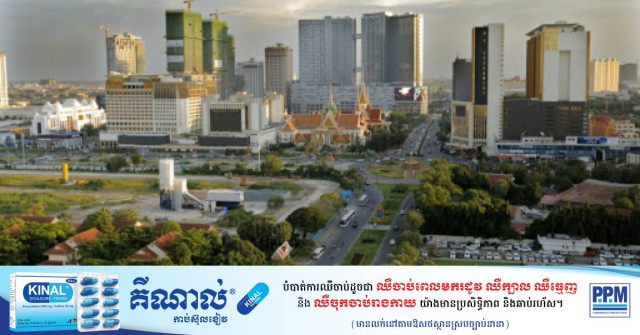Water, Forests and Temples: The Inseparable Elements of Siem Reap
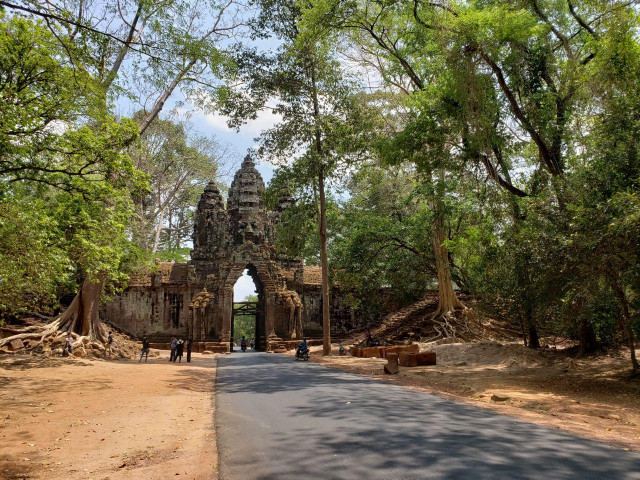
- Ky Soklim
- September 15, 2020 12:37 PM
The influence of nature on human invention and creativity can be seen in the construction of Angkor Wat Temple. Built around the early 12th Century during and after the peak of the Khmer Empire, this abandoned city of the ancient period has left the modern population with many archeological and cultural mysteries.
However, modern architecture has seen a deterioration of the relationship between natural resources and man-made structures. Prior to the introduction of numerous forms of technology, ancient architects were forced to rely on nature—water, forests and temples became a combination that has stood the test of time in Siem Reap.
Angkor and Beyond is a collaborative documentary program created by the Apsara National Authority and ThmeyThmey. Ky Soklim—a senior journalist at ThmeyThmey—interviews Hang Peou, the director general of the Apsara National Authority, as they slowly walked through the lush fields of the Angkor Wat Temple’s inner boundary.
Ky Soklim: Why did the Apsara National Authority decide to collaborative on Angkor and Beyond? What are the reasons behind this decision?
Hang Peou: There has been lots of study and research conducted by many foreign countries on our temples. Most of their documentations are published in foreign languages. Yet, we still somehow lag behind in terms of how our own citizens are informed about our temples and our cultures in a more in-depth look. At the same, even though there are a number of foreign publications who have covered Angkor Wat, there are many limitations.
Among the challenges is the matter of how large Angkor Park actually is. The Park covers around 401 square kilometers of land in which 91 temples, among the thousands, are registered in the World’s Heritage list. Previous publications mostly cover the larger temples. However, with this collaborative publication between the Apsara National Authority and ThmeyThmey, we plan to showcase everything from the large temples to other smaller temples—many of which are known only by name and are rarely experienced by people. Knowing and understanding the park in its full splendor will help to build a better understanding of the Khmer Empire, both in terms of scope and scale.
Ky Soklim: Based on the existing documentation, in the province of Siem Reap alone, how many temples are there?
Hang Peou: If we also include the ruined temples of all sizes, as well as the historical hills—hills that have been influenced by human activities throughout history—there are up to 1,000 temples and historical hills in Siem Reap Province.
Besides from the temples, we will also focus on the abstract heritage. The value of Angkor is not just the stones that we can see—there is much more to the entire story. The local traditions such as the rain-requesting ceremony and other forms of ritual ceremonies, as well as the changes of use in the locals’ day-to-day lives. We want to safeguard all of these documents so that they can become memories for the future. Abstract heritage should not be demonstrated only through writing alone. It should also be shown through video recordings, through human gestures and more. Some of the cultural or ritual ceremonies that are still being practiced in this Angkor Park will one day soon come to an end. Why? Because these days more people are busier. Some ceremonies requires the helping hands of many local people to organize and participate. The Koa Juk, as well as the Chlang Vei ceremony, are slowly disappearing due to the modernized way of living. Since 2012, the Apsara National Authority has been continuously collecting and documenting the abstract heritage in the Angkor Park.
Ky Soklim: Apart from documenting these important heritages, has the authority implemented anything to actually conserve the heritage of Angkor Wat?
Hang Peou: The reason that we are documenting them is to conserve them. However, conserving the abstract heritage requires the help of the local people. So how do we protect these heritages when one day they are going to disappear? Every bit of documentation and information that we receive will be converted into touristic programs. Which mean, we help local people in making their living through the ceremonies that they themselves protect. This could be one of the goals for tourism in the future. However, right now, we are in the stage of collecting the crucial information. In this case, even when things are ready, it does not mean that those cultural ceremonies will be performed for the tourists on a daily basis. The ceremonies will be celebrated based on local people’s cultural calendar. For this, there will be official announcements informing the tourists about the ceremonial celebrations.
 Ky Soklim: How purely traditional are the ceremonies performed these days? Have they retained their historical accuracy and purpose or have they evolved with the times?
Ky Soklim: How purely traditional are the ceremonies performed these days? Have they retained their historical accuracy and purpose or have they evolved with the times?
Hang Peou: I cannot say for sure if they still retain their pure form from centuries ago, as we do not have any surviving documentations to clearly confirm this. However, we believe that there are surely some changes that have occurred over time. However, the changes can be minimal. Some ceremonies are at risk of disappearing because they are not being practiced that frequently anymore, such as the Chak Chek—the banana leaves shape-folding ceremony. This ceremony involves folding banana leaves into the shapes of flowers as decorations. Nowadays, people can just go and print the decoration from the printing shops and the products look pretty much indistinguishable from afar, but the value is different. The value of human efforts, human thinking and human creativity.
Ky Soklim: While visiting Siem Reap Province, some locals as well as foreign tourists simply consider the temples to be just stones. For others, those stones are actually embodied by mythical souls and history. For yourself, as an expert, are temples just ordinary stones or are they the embodiment of mythical souls?
Hang Peou: For us, as the personnel who conduct research and look after this region, it is understood that these temples are not just stones. Otherwise, they will not be standing here for centuries. An object which is not alive will be unable to be taken care of from one generation to the other. These places are the creation of many previous kings who had clear goals for the future. At the same time, there have always been many people who frequently visit the temples for worshipping. The temples are alive because they contain abstract heritage. The Angkor Wat Temple has been a symbol on our flag for a very long time. People from all classes throughout different historical periods have been coming here to worship. The international community such as the UNESCO has put the Angkor area under their protection since the year of 1992, even before we have a properly-established government. All in all, the temples do have their own souls.
Ky Soklim: The Angkor Wat Temple is now almost a millennium old. Obviously, it has withstood heat, rain and other natural elements. Do you think the temple structures actually have a health status similar to that of the human beings? Will they survive simply forever, or do they really need to be maintained and fixed?
Hang Peou: Realistically speaking, all objects in this world have their own specific time period. An object that survives long is an object that has soul. A soul that has been saved and taken care of by the people. The Angkor Wat Temple has been continuously fixed. At the same time, the damage is not really that concerning due to the protection from the surrounding nature. Trees help reduce the temperate of the surrounding atmosphere around the temple.
Ky Soklim: I am no expert in this field, but why does the moisture from the surrounding trees not erode the temple stones?
Hang Peou: The nature of this moisture is unlike the one that you would find inside a normal room. It is not the moisture that you would get, let’s say, from applying a wet cloth onto on the temple stones. That would induce erosion, but this kind of moisture actually help protect the temples. On the other hand, unlike modern constructions, the temples’ inner structure is not reinforced by steel. The temple stones are pretty much stacked on top of one another. In a case of strong wind, problems could happen.
The Angkor Wat Temple is also situated between Mount Kulen and the Tonle Sap River where wind speed can be strong. The surrounding trees actually help reduce the wind speed. Furthermore, through our research and excavation, we have found that these temples are actually supported by sand which acts as the foundation. Simply speaking, wet sand can withstand more pressure than dry sand. That is one of the reason why many temples are equipped with the surrounding moats. The moats’ functionality is also to make sure that the temples does not get flooded. On the other hand, its function is to also hydrate the sand beneath the temples so that the foundations remains strong and stable. The geological land in Siem Reap Province cannot naturally withstand heavy pressure. So, our ancestors were finding sustainable ways in building their temples. For that matter, some small temples fell completely to the ground due to the insufficient amount of underground water. The Angkor Wat Temple does not really face this very issue since its surrounding moat is proportionally sufficient. But, for the smaller temples, that is not really the case.
Ky Soklim: Currently the whole world is very much concerned about the shortage of fresh water as well as the more intense droughts due to the changing climate. Recently, the water level in the Mekong River has dropped due to a range of reasons. Do the temples’ moats also experience water shortages? Following this questions, where does the water inside those moats actually come from in the first place?
Hang Peou: Since 2004, we have been restructuring the irrigation system and we still collect water from the ancient water system. As for this year, we have collected lower quantities of water. We have fixed some of these ancient water systems to further assist the flow of water into the temple moats. The ancient architects found ways in building these systems and keep it functioning by using the forces of nature. A much larger water reservoir like the Baray was built on an elevated ground. With the difference in elevation, the water from the Baray can be transported by making its way naturally through the underground soil into the temples’ moats. During the rainy season, the water is transported normally through the above ground canal system. But during the dry season, the water is transported underground just like what I have explained just now. These days, water is being pumped from underground for usage which also raises some concern over the safety of the temples.
Ky Soklim: What is the purpose behind the introduction of a road exclusively for cycling inside the Angkor Park? Do you want the Angkor Park to be a green sustainable area?
Hang Peou: For some tourists, even though the temples have so many stories to learn from, a prolonged visit, let’s say, up to three days straight might also be very tiring to continue. So, that is why, by constructing new cycling routes, we are trying to create a new activity in which tourists can enjoy spending more time in the forest area of the Angkor Park. On the other hand, youngsters who frequently cycle to school have to put themselves along the roads with other big vehicles which can be unsafe for them. These new cycling routes will be build 10 meters or 20 meters parallel to the main roads.
Ky Soklim: As I spoke to some experts some time ago, the erosion and some of the destruction that occurs on the temple stones are not always a bad thing to see. Sometimes, they are actually perceived as beauty. According to your own understanding, do you think it is a beauty or does it need to be fixed right away?
Hang Peou: Our team of experts frequently come and monitor the conditions of the temples. Sometimes, beauty is not always the priority. We try to focus our attention toward the functionality of that individual part of a temple, like a pillar for instance, to assess its condition and importance. Sometimes, travelers can see some temples’ pillars being wrapped around by several iron belts. It does not mean that the authority is lazy or they do not want to do their best. Instead, that individual pillar, although it may experience some noticeable erosion, could still withstand the pressure from above. Apart from that, the replacement of a new pillar can somehow take away the originality of that particular part of the temple.
Ky Soklim: Can these temples survive intact for, let’s say, another millennium?
Hang Peou: It depends on how we look after our temple. If we keep a good watch on them, then these temples are more likely to be here for a much longer period of time. If not, then the longevity of their survivability will be shortened accordingly.
Ky Soklim: For many years the Apsara National Authority of Cambodia has been planting trees, especially inside the Angkor Wat Temple and around the Angkor Park as a whole. How are trees important to the temples? What are the relationship between the temples and the trees surrounding them?
Hang Peou: Since 2004, the Apsara National Authority of Cambodia has planted trees to promote conservation. Trees have three crucial roles. These elements are temples, water and forests. These elements live together. Meaning that, in our culture of conservation, these elements cannot be divided from one another. Beside from the functionality of shade, trees also play a very important duty in creating moisture. The temples withstand lots of heat, as we all know. We have done collaborative research with foreign countries and it shows that, with the absence of trees, the temple stones experience strong fluctuation in temperature which allow those stones to decay. For the trees, they create moisture through the process of photosynthesis. The moisture reduces the heat coming directly from the sun onto the temple stones. This makes the temple stones healthier. Because of the presence of moisture, it also introduces the growth of moss along the stones’ surfaces. These layers of moss act as another protective layer which further accommodate the temple stones from corrosion.
Ky Soklim: So, counter-intuitively, the moss does not deteriorate the temple stones?
Hang Peou: It depends on the type of the moss. For the type of moss that grows naturally from moisture during the rainy season and disappears again during the dry season, they act more as protective layer. However, people usually see them as a threat to the temple stones, but they are not. It has been confirmed by the team of foreign scientists such as the French and the Japanese. On the contrary, this type of moss cannot grow without moisture.
Furthermore, this temple region stands between the Tonle Sap Lake and mount Kulen. Strong wind is not a good thing for the stability of the temples. These temples were built by stacking the stones of top of one another. Because of this, some temple stones can be easily toppled by strong wind. With more and more trees, the wind speed can be reduced. Another important aspect is the layer of wet sand beneath the temple’s foundation. With dry sand, the temple’s weight cannot be safely withstood. Our ancestors used this concept in the construction of these temples. They excavated the land and filled it with sand. The sand is neither too fine nor too big. This sand structure has its relation with the underground water. As trees provide shade, they also reduce the rate of evaporation from the soil. Therefore, trees retain a healthy amount of moister and water beneath our feet.
Ky Soklim: From the beginning of your tree-planting campaign until now, what is the estimated number of trees that have been planted around the temples?
Hang Peou: If our calculation is correct, a few million trees have already been planted around the temple zone. Actually the tree-planting campaign is not implemented just only around some of the temples that we usually see. It is being implemented all across the Angkor Park. It does not mean that we only have to plant trees near the temple structures. Planting trees very close to the temples can be dangerous. We actually have to plant them all throughout the Angkor Park.
Ky Soklim: There is a common view saying that, during the dry season, the grass around the temples—especially the Angkor Wat Temple—becomes very hot and dry. Some people were saying that it should not happen this way. Is this a thing which, instead, need to be conserved, a thing that has not been thought out or a thing that is not prioritized yet? Can you please elaborate this?
Hang Peou: It is not that the authority has not put this matter into consideration. There are many things that have to be prioritized. We also do not need to be informed by the general public in order to be able to do our jobs. We have a clear plan of our own. The part where we want the Angkor Wat Temple’s surrounding to be greener has been raised for the fourth year now. Firstly, we need to request the UNESCO since we need to excavate the soil in order to install the pipeline. There has to be a conducted study by the experts. After the each of our meeting, we submit our documentation for them to inspect. Any plans that are proposed have to contribute positively back to the temple. That is why it can take up to three years before they allow us to execute the plans. The UNESCO team will evaluate our process of doing so. In this year, we are going to embed the pipeline. For the next year’s dry season, the temples’ surrounding might be greener.








